
PREV ARTICLE
NEXT ARTICLE
FULL ISSUE
PREV FULL ISSUE
HERITAGE 2020 CENTRAL STATES SALE SELECTIONSThe upcoming Heritage sale has been moved as a result of the 2020 Central States show cancellation. But even those who can't travel can view and bid from afar. Here are a few lots that caught my eye. -Editor 1791 Washington President Cent
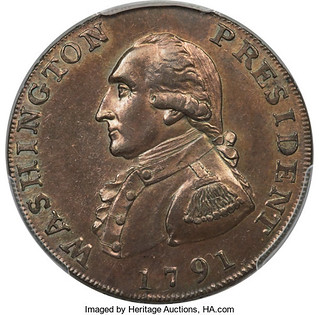 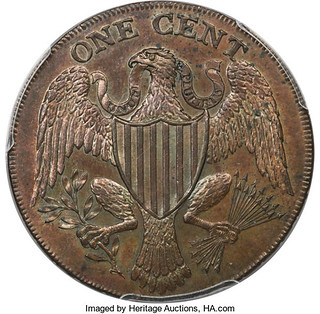 This item is currently being reviewed by our catalogers and photographers. A written description will be available along with high resolution images soon. The lot description for this piece is still being drafted. Stay tuned. That's part of the fun of an upcoming sale. With items being made public while still under evaluation, the public has a chance to see and comment on the material, enabling the catalogers to catch things they might otherwise miss. -Editor To read the complete lot description, see:
1811 Half Cent
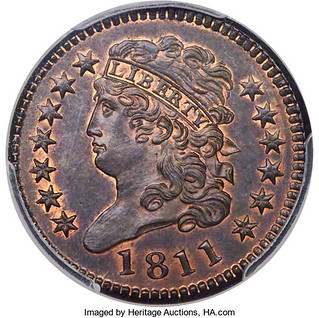 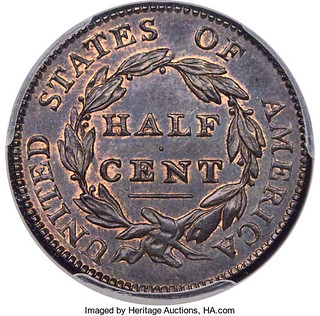 The 1811 Classic Head Half Cent
Two die varieties that share a common reverse are known for the date. This coin represents the C-1, B-1 variety, with a Wide Date that shows the numerals 1 and 8 widely separated and the E in LIBERTY repunched over a smaller E. Although the Classic Head half cents did not circulate as extensively as their earlier Draped Bust counterparts, most examples of the 1811 C-1 are well-worn and Ronald Manley notes the variety is seldom seen in grades above the Fine level. The 1811 C-1 is more elusive than the C-2 variety and Bill Eckberg (2019) estimates the surviving population at 150 examples in all grades. The 1811 was a collector favorite from the earliest days of the hobby and by the late 1850s, when coin collecting first became widespread in this country, the issue was already known as a sought-after rarity. In his American Numismatical Manual (1859), Montroville W. Dickeson described the 1811 as "rare and valuable, as they are to be found in few cabinets." Examples began appearing at auction as early as lot 106 of the A.C. Kline Sale (Moses Thomas & Sons, 6/1855). The lot realized $.75, a strong price at the time. The present coin established the current prices realized record for this issue when it sold for a remarkable $1,121,250 in the Missouri Cabinet in January 2014. A great classic coin. -Editor To read the complete lot description, see:
1858 Proof Liberty Eagle
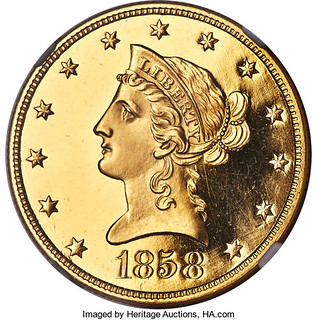 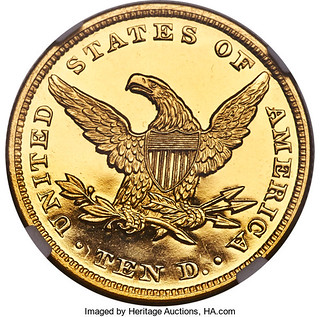 1858 $10 PR64 Ultra Cameo NGC. CAC. JD-1, High R.7. Ex: Trompeter. The Philadelphia Mint began its program of commercial proof coin offerings in 1858. Mintage figures for proofs were not recorded that year, but experts agree no more than four to six proof Liberty eagles were produced. Most of the coins we know about today were issued as part of six-piece gold proof sets, but it is possible that a few examples were sold singly, as well. Only four examples have been reliably reported, and we believe three of those coins are included in institutional collections at the Smithsonian Institution, the American Numismatic Society, and the Connecticut State Library (see roster below). The magnificent coin offered here is the only example available to collectors, making this lot an extremely important opportunity for series specialists and Registry Set enthusiasts. The Present Coin
"Perfect brilliant proof! By far the rarest of all U.S. $10.00 Gold Pieces and one of the rarest of all U.S. Gold Coins ... the specimen here offered is the only brilliant proof specimen available for purchase ... This great coin in its magnificent condition, is in point of actual rarity, almost on a par with the 1822 Half Eagle ... Its addition to a collection of U.S. Gold Coins would have the same effect as the addition of an 1804 Silver Dollar to a Silver Collection. It would greatly enhance the interest and value of the balance of the collection." Amon Carter, Sr. purchased the coin at the auction, and it remained in the Carter Family Collection until that spectacular numismatic gathering was sold in January of 1984. This coin realized $121,000 at the Carter sale, a remarkable price for any coin at the time, to David Akers, acting as agent for proof gold specialist Ed Trompeter. It has not been publicly offered since. The owner of the Duquesne Collection purchased this coin privately via Heritage Auctions, along with many other coins from the Trompeter Estate, in 1998. An amazing coin with an equally amazing provenance. -Editor To read the complete lot description, see:
1872 Seated Dollar in Copper
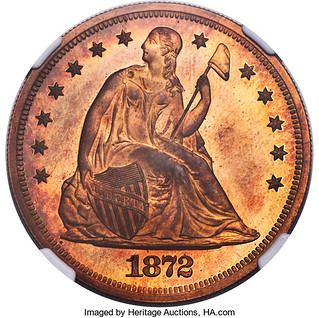 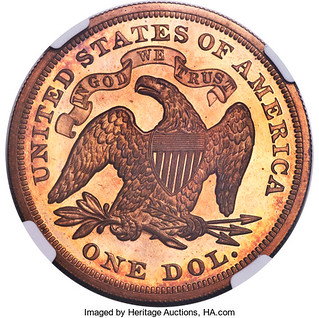 1872 Seated Dollar in Copper
1872 $1 Dollar, Judd-1210, Pollock-1350, High R.7, PR66? Red and Brown Cameo NGC. The regular Seated Liberty With Motto design, the motto boldly doubled as seen on regular issue proofs dated 1872 and 1873. Struck in copper with a reeded edge. The 1872 copper dollars from the regular dies were not trial pieces as often recorded, but instead were part of off-metal coinage sets that the Mint marketed to contemporary collectors. The off-metal pattern sets were coined in both copper and aluminum (Judd-1211). It is doubtful that many sets were actually purchased by collectors, as only two examples of the copper dollar are known today. I've always had a soft spot for patterns. Very cool piece. -Editor To read the complete lot description, see:
 Wayne Homren, Editor The Numismatic Bibliomania Society is a non-profit organization promoting numismatic literature. See our web site at coinbooks.org. To submit items for publication in The E-Sylum, write to the Editor at this address: whomren@gmail.com To subscribe go to: https://my.binhost.com/lists/listinfo/esylum All Rights Reserved. NBS Home Page Contact the NBS webmaster 
|